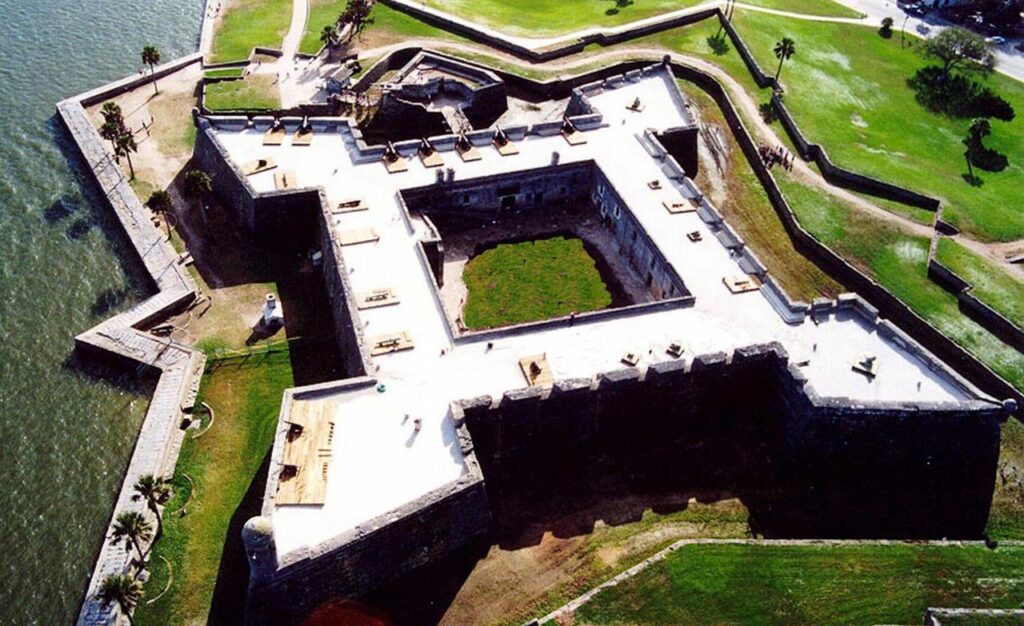During the time the Spaniards still occupied Florida they built a fort out of a sedimentary rock that was formed from compressed shells of dead marine life. But what is the significance of this particular material and what was the mystery behind the cannonball-eating fort?
Castillo de San Marcos, a Spanish-built fort in Florida, was made of coquina sedimentary rock. While it is not clear if the Spanish knew about the rock’s properties when the fort was built, it withstood the damage of British cannon balls by “swallowing” it.
The Mystery Behind the Castillo de San Marcos
An English fleet from colonial Carolina attacked Castillo de San Marcos, a Spanish stronghold on the Atlantic coast, in 1702, when the Spanish still held Florida.
The fort guarded the Spanish empire’s trade lines and the nearby city of St. Augustine, and the English intended to take control of this strategically important stronghold. The English boats, led by Carolina’s governor James Moore, dropped their anchors and laid siege.
However, the fort’s walls stood firm despite being bombarded with cannonballs and gunfire for nearly two months. It appeared as though they were swallowing the British cannonballs embedded in the stone. The exact mechanism by which the walls accomplished this for the next three centuries remained a mystery.
A cannonball usually causes lengthy, deep cracks in the stone to spread outwards from the point of contact, causing catastrophic damage to a structure. The walls around Castillo de San Marcos were not in this category.
The walls of the fort were made of coquina, a sedimentary rock produced from compacted shells of dead sea animals, which remained unaffected after being attacked by the British. The rock did not splinter but gave way to cannonball similar to how you stick a knife into cheese. (Source: Atlas Obscura)
Scientific Research Done on the Mysterious Fort
A team of material scientists from the University of Florida and the United States Army Corps of Engineers studied the fort in 2015, more than 300 years after it was erected. The Army looked into the physical qualities of coquina to see how it handled impact stress. Phillip Jannotti, a research scientist at the Army Research Laboratory of the Combat Capabilities Development Command, led the team.
I grew up about an hour from San Marcos, so I went there a few times.
Phillip Jannotti, Research Scientist, Army Research Laboratory of the Combat Capabilities Development Command
behavior of materials. By 2013, while working on his Ph.D. in mechanical engineering at the University of Florida with professor Ghatu Subhash, Subhash’s daughter Sanika, a high school student, got interested in the walls’ extraordinary strength. She recommended conducting an experiment to explore the absorption capabilities of coquina.
Jannotti and Subhash purchased a few small coquina samples from the Castillo de San Marcos gift store and fired small steel balls at them at speeds ranging from 110 to 160 mph. The goal was to simulate, albeit in miniature, the collision conditions of a cannon firing.
To visualize how the coquina samples reacted to such impacts, the researchers employed a high-speed camera that took 200,000 photos every second. They conducted similar studies on sandstone and structural foam to compare their qualities to those of coquina.
Subhash learned how to perform experiments and interpret results throughout the two-year project, which Jannotti maintained after completing his Ph.D. and transferring to his Army Research position.
Their findings revealed that, while coquina seems to be a type of sandstone, it acts more like foam towards the end of those two years.
Because of its loosely connected inner structure, coquina had a unique ability to absorb mechanical stress. The little shell fragments that makeup coquina have been stacked and pressed into each other for thousands of years, but they aren’t cemented together, so they can move around.
Coquina is very porous and its shells are weakly bonded together. It acts almost as natural foam, the balls sink in, and slowly decelerate.
Phillip Jannotti, Research Scientist, Army Research Laboratory of the Combat Capabilities Development Command
(Source: Atlas Obscura)

Cool!